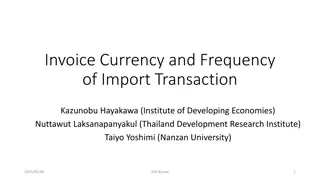Introduction of Currency Board in Bulgaria: Historical Insights and Policy Implications
The introduction of the currency board in Bulgaria in the late 1990s marked a significant departure from past economic policies. The move aimed to restore economic stability by implementing measures to curb inflation, reduce debt burden, and enhance the attractiveness of the national currency. Despite debates and challenges, the adoption of the currency board was believed to offer a more stable and growth-friendly policy framework based on experiences from other countries.
Download Presentation

Please find below an Image/Link to download the presentation.
The content on the website is provided AS IS for your information and personal use only. It may not be sold, licensed, or shared on other websites without obtaining consent from the author.If you encounter any issues during the download, it is possible that the publisher has removed the file from their server.
You are allowed to download the files provided on this website for personal or commercial use, subject to the condition that they are used lawfully. All files are the property of their respective owners.
The content on the website is provided AS IS for your information and personal use only. It may not be sold, licensed, or shared on other websites without obtaining consent from the author.
E N D
Presentation Transcript
SOME HISTORICAN AND CURRENT SOME HISTORICAN AND CURRENT TOPICS OF TOPICS OF INTERNATIONAL INTERNATIONAL ECONOMIC ECONOMIC RELATIONS RELATIONS Insights form Bulgaria Insights form Bulgaria - - The introduction of the currency board Prof. Virginia Zhelyazkova, DSc VUZF University Sofia Guest lectures at University of Macedonia - Thessaloniki 22 26 May 2023 1 Internal Use Internal Use
4. The introduction of the currency board Source: Gulde, Anne-Marie, The Role of the Currency Board in Bulgaria's Stabilization, Finance and Development Magazine, IMF, available here: Finance & Development, September 1999 - The Role of the Currency Board in Bulgaria's Stabilization (imf.org) 2 Internal Use
Policy discussions and constraints There was growing awareness that a visible and credible departure from past policies would be necessary to restore any semblance of normality to the economy. In addition, stabilization would require measures to prevent financial indiscipline, reduce the government's overwhelming debt-service burden, and increase the lev's attractiveness, as well as strong official commitment to reforms and widespread public support. 3 Internal Use
Policy discussions and constraints. In November 1996, an IMF mission initiated the first discussion with the Bulgarian authorities and major interest groups including all political parties and trade unions, foreign donors, journalists, and academics on the merits of a currency board. The idea aroused considerable debate. Proponents felt that a currency board offered an ideal solution to the problems of high inflation, lavish central bank lending to banks, and excessively high interest rates on government debt. 4 Internal Use
Policy discussions and constraints Under the currency board, the central bank would lose its discretion to act, and inflation and real interest rates would drop toward the levels of those in the country issuing the anchor currency. The more credible policy environment would provide a better framework for stability and growth. Experience in countries that had adopted currency boards Argentina, Estonia, Hong Kong SAR, and Lithuania supported these arguments. 5 Internal Use
Policy discussions and constraints Critics did not dispute the potential advantages of a currency board arrangement but argued that Bulgaria did not meet the necessary preconditions. Most important, Bulgaria's banking sector was bigger and plagued with more problems than the banking sectors of most other countries that had adopted currency boards, and the need for lender-of-last-resort lending could not be ruled out. In addition, temporary access to central bank overdrafts was thought to be necessary to deal with strong seasonal fluctuations in fiscal revenues and to cover the redemption of bond issues. Finally, international reserves were low and a currency board might require a large up-front devaluation. 6 Internal Use
Policy discussions and constraints Given the complexity of the issues and the country's political problems, the decision to go for the currency board was finalized only when a new government took office in the spring of 1997. The preparation and design phase which was protracted because of the many political and technical uncertainties included a full evaluation of the banking sector to minimize the potential disruptions from an unexpected worsening of the banking crisis. Supporting measures in particular, a significant strengthening of the central bank's banking-supervision capabilities were also designed. 7 Internal Use
Policy discussions and constraints The near-hyperinflation of late 1996 and early 1997 although difficult and costly helped ensure the viability of the currency board. By reducing the real value of domestic debt, which had initially been a threat to a balanced budget, it made fiscal management without recourse to the central bank possible. Furthermore, it gave banks breathing room by rapidly devaluing their domestic currency liabilities while increasing the real value of the dollar-denominated government bonds they held. 8 Internal Use
Design and implementation Currency board arrangements differ significantly from country to country. (See Bali o and others, 1997.) The key features of a currency board that need to be decided upon at the outset of the planning process include the peg currency, the exchange rate, the organizational structure, and the operating principles and instruments. In Bulgaria, there were heated discussions about the choice of anchor currency. 9 Internal Use
Design and implementation Some advocated the U.S. dollar, noting its widespread use in informal transactions and as a store of value, while others supported the deutsche mark as more consistent with the country's trade structure and conducive to greater integration with the European Community. The final decision in favor of the deutsche mark was made in the late spring of 1997. The decision on the exchange rate lev 1,000 to DM 1 was not reached until June 5, 1997. However, because market participants knew that the BNB's foreign reserves would have to cover its monetary liabilities, they were not taken by surprise. The market rate on May 31, 1997, was lev 922.41 per DM 1. 10 Internal Use
Design and implementation Early in the discussions, it was decided that transparency would be greatest under the Bank of England model. The BNB was reorganized into three departments issue, banking, and banking supervision. Full accounts for all departments are published monthly. The issue department holds all of the BNB's monetary liabilities banknotes and coins, and deposits from banks and other nongovernmental parties, the government, and the banking department. The BNB is required to have sufficient foreign exchange and gold assets at all times to cover these liabilities in full. 11 Internal Use
Design and implementation The issue department is required to issue and redeem monetary liabilities for the peg currency at the official exchange rate on demand and without limit. Its accounts must be published weekly to ensure adherence to the currency board rules. Because of the problems facing Bulgaria's financial sector, a separate banking department was established, and the currency board has "excess coverage" that is, more foreign exchange than needed to cover the central bank's monetary liabilities. 12 Internal Use
Design and implementation The banking department deposits these supplemental funds, which can be used to make collateralized loans to commercial banks in the event of an acute liquidity crisis, in the issue department. The banking department also holds all other assets and claims on the central bank, including outstanding long-term loans to the government and long-term deposits by commercial banks, and acts as the fiscal agent for Bulgaria's relations with the IMF. Banking department claims and liabilities other than those related to IMF drawings, lending to commercial banks, and changes related to the deposit of central bank profits will not be added to during the operation of the currency board. 13 Internal Use
Design and implementation The BNB law had to be changed to provide a legal basis for the new currency board. The law was drafted by a committee composed of the BNB's legal department, the ministry of justice, and the prime minister's cabinet. Following up on other consensus-building measures by the authorities, in April 1997, the IMF sponsored a seminar on currency boards for Bulgarian parliamentarians. The BNB law, passed by the parliament on June 5, took effect on July 1, 1997. 14 Internal Use
Design and implementation In addition, measures to address likely stress factors were incorporated into the BNB law and the stabilization program. Two measures were designed to end large-scale monetary financing of the budget. First, the new law allows onlending of IMF credits to stabilize the budget, although strict safeguards and transparency requirements apply. Second, a fiscal reserve account was created to help make any short- term central bank financing of the budget unnecessary, and all central government deposits and the accounts of the 12 major extrabudgetary funds were consolidated in this account. 15 Internal Use
Design and implementation The balance in the fiscal reserve account held in the BNB's issue department and fully covered by foreign reserves represents the funds available to the government at any given time. Maintaining a minimum balance in the account, as required under Bulgaria's IMF-supported program, provides assurance of the government's ability to honor its budgetary commitments and is therefore an important stabilizer. 16 Internal Use
Design and implementation To increase confidence in the banking system, the currency board plan provided for the possibility of banks' receiving limited but sizable assistance (about $300 million, or one-fifth of Bulgaria's foreign reserves at the inception of the currency board) through the banking department. Banking laws and prudential regulations were strengthened. In addition, the BNB embarked on a major technical assistance program, coordinated by the IMF and supported by the European Union and the United States Agency for International Development (USAID), to enhance banking supervision. Finally, the authorities recapitalized one large state bank and pledged to renew efforts to privatize the remaining state banks and improve the operating environment for banks. 17 Internal Use
Reorganization and transition issues The final task was to ensure a smooth transition. This was complicated by the fact that new BNB management took office in May 1997 and had only two months to familiarize itself with the principles of a currency board arrangement and make final decisions. In early June, a number of issues still required urgent attention. 18 Internal Use
Reorganization and transition issues Restructuring the country's foreign exchange reserves in line with the peg to the deutsche mark was a priority. Before the currency board plan, reserves had been composed of a wide variety of instruments and currencies, including gold and other precious metals, a variety of foreign currencies held in bank accounts, and bonds and other investments. Given the necessity of safeguarding the value of the country's foreign exchange holdings, the country decided the best choice was deutsche mark-denominated assets. 19 Internal Use
Reorganization and transition issues The BNB's accounts had to be separated to fit into the currency board structure. An ad hoc committee consisting of the deputy governor in charge, the head of the accounting department, and IMF advisors developed the final accounting framework. On June 30, 1997, the BNB prepared a closing balance on the basis of the former accounting framework, and the currency board's opening balance on July 1, 1997, reflected the new structure. 20 Internal Use
Reorganization and transition issues Management of the government's domestic debt was another challenge. To avoid wide swings in liquidity, the ministry of finance agreed to avoid making large injections of liquidity on days when, because of the earlier bunching of debt issues, large repayments would fall due. A committee of managers from the ministry of finance and the BNB was to consult regularly on this issue. To smooth implementation, a special treasury bill issue was scheduled for June 30 to absorb an exceptionally large liquidity injection that day. 21 Internal Use
Reorganization and transition issues The final issues had to do with logistics. To reassure the public, the BNB and its branches needed to have available an adequate supply of deutsche mark banknotes. Given that the deutsche mark had not previously been used with any frequency in Bulgaria, the BNB had to acquire the cash from abroad and send it in time to the distribution points, all of which was successfully accomplished. 22 Internal Use
Implementation and outcomes The introduction of the Bulgarian currency board went smoothly and in line with appreciating pressure on the lev before the actual shift took place with no attempts to "test the system." In about 1,500 cash transactions, the BNB bought more than DM 3 million while selling less than DM 1,000. The BNB was also a large net purchaser of deutsche mark in the interbank market. The total increase in reserves after the first day came to more than DM 40 million. 23 Internal Use
Implementation and outcomes Under the currency board, Bulgaria reduced annual inflation to 13 percent by mid-1998 and to 1 percent by the end of 1998 while rebuilding foreign exchange reserves from less than $800 million to more than $3 billion more than six months of imports (see table). The BNB basic interest rate, which had been above 200 percent at the height of Bulgaria's economic crisis, fell to 5.2 percent by the end of 1998. Retail interest rates moved close to German levels as soon as the currency board was introduced. 24 Internal Use
Implementation and outcomes Since inception of the currency board, no bank has had to be supported through the banking department. Because of bottlenecks other than the monetary arrangement, the resumption of growth to date has remained moderate, but Bulgaria's stabilization was not disrupted by Russia's crisis of mid-1998, despite close economic ties between Bulgaria and Russia Bulgaria's experience highlights the power of a credible, rule-based system to rapidly change perceptions and economic behavior. 25 Internal Use
Implementation and outcomes But it also underscores three cautionary lessons: First, a currency board requires more preparation than other stabilization programs, and preparation of a different kind. Because the changes can be time-consuming, a currency board may not be possible in countries that have not met the preconditions. Second, because of the legal changes required to implement a currency board, broad parliamentary support is needed. Bulgaria was able to garner support for its currency board because near-hyperinflation had made clear the need for radical solutions and because it had taken pains to build a consensus well in advance of the plan's inception. Third, a currency board is but one element of a stabilization program. Although it will, if properly designed, contribute to eliminating macroeconomic imbalances, its long-term survival depends equally on the implementation of appropriate supporting measures. 26 Internal Use























